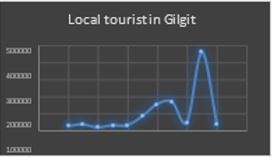Thematic Analysis of Tourism Downfall and Economic Consequences During Covid-19: Evidence from A Rural Mountain Community in Pakistan
Keywords:
Thematic theory, Questioner outcomes, Descriptive Analysis, COVID-19, Gilgit Baltistan (GB)Abstract
The COVID-19 pandemic had a profound impact on the tourism industry in Gilgit-Baltistan, leading to a significant reduction in tourist arrivals and severely affecting the local economy. This study demonstrated that the livelihoods of many residents, particularly those involved in tourism-related businesses, were adversely affected. The analysis revealed substantial monthly losses in tourist arrivals in 2020 compared to 2019, with a marked decline in the summer months, typically the peak season for tourism in the region. The thematic analysis highlighted the socio-economic challenges faced by the local population, including loss of income, business closures, and a decline in living standards. The study also emphasized the need for strategic interventions to support the tourism industry in Gilgit-Baltistan, including the development of policies to enhance resilience against future disruptions. The integration of advanced data analysis techniques and Geographic Information Systems (GIS) provided a comprehensive understanding of the pandemic's impact, contributing valuable insights for policymakers and stakeholders in the tourism sector.
References
R. Chandel, S. Kanga, and SK Singh, “Impact of COVID-19 on tourism sector: a case study of Rajasthan, India,” Geosciences, vol. 7, no. 2, pp. 224–243, 2021.
John S. Akama and Damiannah Kieti, “Tourism and Socio-economicDevelopment in Developing Countries:A Case Study of Mombasa Resort in Kenya,” J. Sustain. Tour., vol. 15, no. 6, pp. 735–748, 2007.
Nuno Fernandes, “Economic Effects of Coronavirus Outbreak (COVID-19) on the World Economy,” SSRN, 2020.
Carson Duan, “Thematic evolution, emerging trends for sharing economy business model research, and future research directions in the post- COVID- 19 era,” R&D Manag., 2023.
Rodney Jackson, “Pakistan’s Community-based Trophy Hunting Programs and Their Relationship to Snow Leopard Conservation,” 2004.
T. Bas and Sheeja Sivaprasad, “Tourism and socio-economic development in developing countries: A case study of Mombasa Resort in Kenya,” Econ. Financ. Anal. Glob. Natl. Dev., pp. 355–369, 2022.
Tugba Bas and Sheeja Sivaprasad, “An Exploratory Insight into the Impact of COVID-19 on the Travel and Tourism Sector: UK Evidence,” Econ. Financ. Anal. Glob. Natl. Dev., pp. 55–369, 2022.
A. Khan, S. Bibi, A. Lorenzo, J. Lyu, and Z. U. Babar, “Tourism and development in developing economies: A policy implication perspective,” Sustain., vol. 12, no. 4, pp. 1–19, 2020, doi: 10.3390/su12041618.
C. F. Tang and E. C. Tan, “How stable is the tourism-led growth hypothesis in Malaysia? Evidence from disaggregated tourism markets,” Tour. Manag., vol. 37, pp. 52–57, 2013, doi: 10.1016/J.TOURMAN.2012.12.014.
A. Rehman et al., “Economic perspectives of major field crops of Pakistan: An empirical study,” Pacific Sci. Rev. B Humanit. Soc. Sci., vol. 1, no. 3, pp. 145–158, Nov. 2015, doi: 10.1016/J.PSRB.2016.09.002.
U. Khan, “Does Tourism Boost Economic Growth: Evidence from Italy,” Int. J. Econ. Bus. Adm., vol. VIII, no. Issue 4, pp. 214–222, Oct. 2020, doi: 10.35808/IJEBA/581.
S. Kousar, A. Rehman, M. Zafar, K. Ali, and N. Nasir, “China-Pakistan Economic Corridor: a gateway to sustainable economic development,” Int. J. Soc. Econ., vol. 45, no. 6, pp. 909–924, 2018, doi: 10.1108/IJSE-02-2017-0059.
A. M. Mohamed Mustafa, “Contribution of tourism and foreign direct investment to gross domestic product: Econometric analysis in the case of Sri Lanka,” J. Asian Financ. Econ. Bus., vol. 6, no. 4, pp. 109–114, Nov. 2019, doi: 10.13106/JAFEB.2019.VOL6.NO4.109.
L. Jamel, “THE RELATION BETWEEN TOURISM AND ECONOMIC GROWTH: A CASE OF SAUDI ARABIA AS AN EMERGING TOURISM DESTINATION,” Virtual Econ., vol. 3, no. 4, pp. 29–47, Oct. 2020, doi: 10.34021/VE.2020.03.04(2).
W. C. Po and B. N. Huang, “Tourism development and economic growth-a nonlinear approach,” Phys. A Stat. Mech. its Appl., vol. 387, no. 22, pp. 5535–5542, Sep. 2008, doi: 10.1016/J.PHYSA.2008.05.037.
BL Berg, QUALITATIVERESEARCH METHODSFO RTHE SOCIALSCIENCES. 2001.
Virginia Braun and Victoria Clarke, “Using thematic analysis inpsychology,” Qual. Res. Psychol., vol. 3, pp. 77–101, 2006.
W. Ali, I. Hussain, and Sabbor Hussain, “Covid-19: People Perception Knowledge and Experience: an Evidence from Gilgit-Baltistan Pakistan,” Int. Trans. J. Eng. Manag. Appl. Sci. Technol., vol. 12, no. 6, 2021.
Trudie Walters, Using Thematic Analysis in Tourism Research. 2016.
United Nations World Tourism Organization, “Impact of COVID-19 on tourism in small island developing states,” 2020.

Downloads
Published
How to Cite
Issue
Section
License
Copyright (c) 2024 50SEA

This work is licensed under a Creative Commons Attribution 4.0 International License.




















